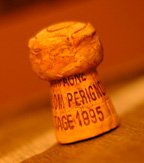|
Bartenders Guide: Champagne & Sparkling Wine
"In victory, you deserve Champagne. In defeat, you need it." "I've never understood why people say 'Champagne goes right to my head'. I've found it's my underwear that get sparkly, first." Champagne has it made. It's so commonly associated with "The Good Life" that people will drink it, just to prove they're having a good time. Saying champagne can't make you happy is like saying that being rich won't make you happy. That may be true, but I've cried in a Lamborghini, and I've cried in a Hyundai...and trust me on this, crying in the Lamborghini was better. There are lots of scientific reasons why champagne really does go to your head, and I'll explain them on the bottom of the page, but mere chemistry doesn't quite cover it. Champagne is magic in a bottle; the closest thing to Tinkerbell's Fairy Dust you and I are likely to see unless you're into Columbian exports. Champagne and Sparkling Wine are similar to Cognac and Brandy, in that they are often essentially the same product...but Champagne is a place, and true Champagne must come from it, to be so labeled. Everything else, is sparkling wine. This only applies to products from Europe, where these laws are enforced. Winemakers elsewhere in the world will often label their product "champagne", much to the dismay of French vintners. Also important, is the way in which Champagne is made, called the méthode champenoise (May-TUD Shahm-pen-WAHZ), which was perfected by Dom Perignon. Many sparkling wines are also made according to this standard, but again, if they do not come from Champagne, they cannot be called "champagne". Using this method, the grapes are harvested and pressed like any wine, with the resulting juice fermenting a few weeks and then resting in stainless steel vats. After this, the process differs from still winemaking. The wine is bottled with extra sugar and yeast, and capped with a soda-cap. Yes, even your beloved Dom and Cristal once had an ordinary Budweiser-style twist-off on top. This process can go from one year to three years or more. When this second fermentation and resting period are over, the yeast and sediment must be removed from the bottle. The bottles are put into a riddling rack, which slowly rotates the now re-fermenting wine from a horizontal position up to a vertical one. This allows the sediment from the second fermentation to slowly slide down into the neck of the bottle, for easy removal. The removal process is called disgorgement. The neck of the bottle is frozen, solidifying the settled sediment into a plug, which is forced out by the pressure of the champagne when the cap is removed. After this, a "dosage" of Champagne is added to top it off, and it is corked with the standard Champagne cork. Neat, huh? I feel like the Bill Nye of Booze, here. There are several other methods for carbonating wine, such as the Metodo Italiano, which is similar to the Charmat process, in that secondary fermentation takes place in vats, instead of the individual bottles. This produces the smaller, longer-lasting bubbles that make Prosecco and Asti so much fun. Lastly, some people do carbonate wine by simple injection of CO2, much like soft drinks, but this results in overly-foamy wines whose bubbles quickly dissipate. To my knowledge, no quality producer of sparkling wines uses this method...with that said however, I have occasionally placed favorite wines in a soda charger to give them a little sparkle and it's a hell of a lot of fun. Be sure to read "The Least You Need to Know" for a glossary of the terms you are likely to see on a champagne bottle, as well as an explanation of "Brut" and other sweetness levels.
Champagne and Sparkling Wine are simply wines that have been infused with Carbon Dioxide, or CO2. In Europe, use of the term "Champagne" is limited to sparkling wines made in the Champagne region of France and produced according to the méthode champenoise (explained above). Everything else must simply be labeled "sparkling wine." Champagne really does go to your head...sort of. Carbonation in any spirit forces the alcohol into your bloodstream faster, resulting in a quicker "buzz". In this way, beer will get you tipsy faster than whiskey, even though whiskey has a higher alcohol content. This also explains why Alka-Seltzer works faster than tablet medicines. Like any other wine, Champagne and Sparkling Wines may be made from white or red grapes, though true champagne may only be made from Pinot Noir (red), Pinot Meunier (red) or Chardonnay (white) grapes. This applies only to champagne; many fine sparkling wines are made with other grape varietals, such as Asti Spumante, which is made from Muscat. Several terms you are likely to see on a sparkling wine bottle: Cuvée: May refer to the blend of wines used to make champagne or a single wine destined for the blend, as in vin de cuvée. Sweetness Levels: Champagne may be either vintage or non-vintage. For vintage Champagne, all of the grapes must be from the same year and the wine must be aged at least three years from the first January following the harvest. Non-vintage Champagnes may use grapes from several years' harvests and must be aged only one year from the first January following the most recent harvest. For Champagne storage, opening, corks vs. screw-enclosures, etc., see my Wine Storage & Opening page, here.
|





